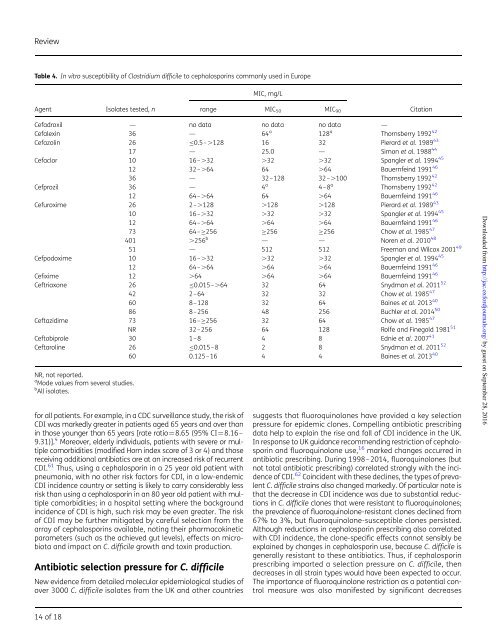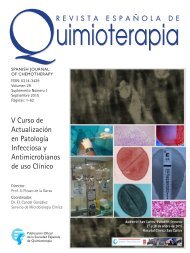http://jac.oxfordjournals.org/
jac.dkw385.full
jac.dkw385.full
Create successful ePaper yourself
Turn your PDF publications into a flip-book with our unique Google optimized e-Paper software.
Review<br />
Table 4. In vitro susceptibility of Clostridium difficile to cephalosporins commonly used in Europe<br />
MIC, mg/L<br />
Agent<br />
Isolates tested, n<br />
range MIC 50 MIC 90<br />
Citation<br />
Cefadroxil — no data no data no data —<br />
Cefalexin 36 — 64 a 128 a Thornsberry 1992 42<br />
Cefazolin 26 ≤0.5–.128 16 32 Pierard et al. 1989 43<br />
17 — 25.0 — Simon et al. 1988 44<br />
Cefaclor 10 16–.32 .32 .32 Spangler et al. 1994 45<br />
12 32–.64 64 .64 Bauernfeind 1991 46<br />
36 — 32–128 32–.100 Thornsberry 1992 42<br />
Cefprozil 36 — 4 a 4–8 a Thornsberry 1992 42<br />
12 64–.64 64 .64 Bauernfeind 1991 46<br />
Cefuroxime 26 2–.128 .128 .128 Pierard et al. 1989 43<br />
10 16–.32 .32 .32 Spangler et al. 1994 45<br />
12 64–.64 .64 .64 Bauernfeind 1991 46<br />
73 64–≥256 ≥256 ≥256 Chow et al. 1985 47<br />
401 .256 b — — Noren et al. 2010 48<br />
51 — 512 512 Freeman and Wilcox 2001 49<br />
Cefpodoxime 10 16–.32 .32 .32 Spangler et al. 1994 45<br />
12 64–.64 .64 .64 Bauernfeind 1991 46<br />
Cefixime 12 .64 .64 .64 Bauernfeind 1991 46<br />
Ceftriaxone 26 ≤0.015–.64 32 64 Snydman et al. 2011 52<br />
42 2–64 32 32 Chow et al. 1985 47<br />
60 8–128 32 64 Baines et al. 2013 40<br />
86 8–256 48 256 Buchler et al. 2014 50<br />
Ceftazidime 73 16–≥256 32 64 Chow et al. 1985 47<br />
NR 32–256 64 128 Rolfe and Finegold 1981 51<br />
Ceftobiprole 30 1–8 4 8 Ednie et al. 2007 41<br />
Ceftaroline 26 ≤0.015–8 2 8 Snydman et al. 2011 52<br />
60 0.125–16 4 4 Baines et al. 2013 40<br />
NR, not reported.<br />
a Mode values from several studies.<br />
b All isolates.<br />
for all patients. For example, in a CDC surveillance study, the risk of<br />
CDI was markedly greater in patients aged 65 years and over than<br />
in those younger than 65 years [rate ratio¼8.65 (95% CI¼8.16–<br />
9.31)]. 4 Moreover, elderly individuals, patients with severe or multiple<br />
comorbidities (modified Horn index score of 3 or 4) and those<br />
receiving additional antibiotics are at an increased risk of recurrent<br />
CDI. 61 Thus, using a cephalosporin in a 25 year old patient with<br />
pneumonia, with no other risk factors for CDI, in a low-endemic<br />
CDI incidence country or setting is likely to carry considerably less<br />
risk than using a cephalosporin in an 80 year old patient with multiple<br />
comorbidities; in a hospital setting where the background<br />
incidence of CDI is high, such risk may be even greater. The risk<br />
of CDI may be further mitigated by careful selection from the<br />
array of cephalosporins available, noting their pharmacokinetic<br />
parameters (such as the achieved gut levels), effects on microbiota<br />
and impact on C. difficile growth and toxin production.<br />
Antibiotic selection pressure for C. difficile<br />
New evidence from detailed molecular epidemiological studies of<br />
over 3000 C. difficile isolates from the UK and other countries<br />
suggests that fluoroquinolones have provided a key selection<br />
pressure for epidemic clones. Compelling antibiotic prescribing<br />
data help to explain the rise and fall of CDI incidence in the UK.<br />
In response to UK guidance recommending restriction of cephalosporin<br />
and fluoroquinolone use, 16 marked changes occurred in<br />
antibiotic prescribing. During 1998–2014, fluoroquinolones (but<br />
not total antibiotic prescribing) correlated strongly with the incidence<br />
of CDI. 62 Coincident with these declines, the types of prevalent<br />
C. difficile strains also changed markedly. Of particular note is<br />
that the decrease in CDI incidence was due to substantial reductions<br />
in C. difficile clones that were resistant to fluoroquinolones;<br />
the prevalence of fluoroquinolone-resistant clones declined from<br />
67% to 3%, but fluoroquinolone-susceptible clones persisted.<br />
Although reductions in cephalosporin prescribing also correlated<br />
with CDI incidence, the clone-specific effects cannot sensibly be<br />
explained by changes in cephalosporin use, because C. difficile is<br />
generally resistant to these antibiotics. Thus, if cephalosporin<br />
prescribing imparted a selection pressure on C. difficile, then<br />
decreases in all strain types would have been expected to occur.<br />
The importance of fluoroquinolone restriction as a potential control<br />
measure was also manifested by significant decreases<br />
Downloaded from <strong>http</strong>://<strong>jac</strong>.<strong>oxfordjournals</strong>.<strong>org</strong>/ by guest on September 28, 2016<br />
14 of 18




